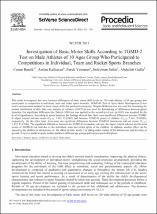| dc.contributor.author | Bastık, Canan | |
| dc.contributor.author | Kalkavan, Arslan | |
| dc.contributor.author | Yamaner, Faruk | |
| dc.contributor.author | Şahin, Süleyman | |
| dc.contributor.author | Gülü, Abdullah | |
| dc.date.accessioned | 2019-05-13T09:07:14Z | |
| dc.date.available | 2019-05-13T09:07:14Z | |
| dc.date.issued | 2011 | |
| dc.identifier.citation | Bastık, C., Kalkavan, A., Yamaner, F., Şahin, S., Güllü, A. (2011). Investigation of basic motor skills according to TGMD-2 test on male athletes of 10 ages group who participated to competitions in individual, team and racket sports branches. Procedia-Social and Behavioral Sciences, 28, 421-425. | en_US |
| dc.identifier.issn | 1877-0428 | |
| dc.identifier.uri | https://doi.org/10.1016/j.sbspro.2011.11.080 | |
| dc.identifier.uri | https://hdl.handle.net/11491/1758 | |
| dc.description | World Conference on Educational Technology Researches, WCETR-2011, 5 July 2011 through 9 July 2011, Nicosia/Kyrenia | en_US |
| dc.description.abstract | This study investigated that were between differences of basic motor skill levels on 120 male athletes of 10 age groups that participated to competition in individual, team and racket sports branches. TGMD-II (Test of Gross Motor Development-2) was used a measurement method for basic motor skills that preferred commonly. Shapiro-Wilkoxon test was used for examining the normal distribution of data. One way analysis of variance (ANOVA) was used for determining of differences between sports branches. For significant differences the Tukey's HSD test was applied as the second-level test. (p<0.05) was accepted for the level of significance. According to sports branches the findings showed that, there were significant differences between TGMDII object control sub-test scores (F2,119; 7.935; P<0.001) and between TGMD-II points of children (F2,119; 7.141; P<0.001), respectively. On the other hand, there were not significant differences between TGMD-II locomotors sub-test scores (F2,119; 1.479; P>0.246). The significant differences between the TGMD-II locomotors sub-test, the object control sub-test and the total scores of TGMD-II can lead due to the individual, team and racket sports of the children. In addition, another effect can be caused by the children in adolescence as the effect of other sports. For taking under control of the adolescence and diversity of growth, it may be useful to apply similar studies in different age groups and various sports disciplines. | en_US |
| dc.language.iso | eng | |
| dc.relation.isversionof | 10.1016/j.sbspro.2011.11.080 | en_US |
| dc.rights | info:eu-repo/semantics/openAccess | en_US |
| dc.rights | Attribution-NonCommercial-NoDerivs 3.0 Unported (CC BY-NC-ND 3.0) | * |
| dc.rights.uri | https://creativecommons.org/licenses/by-nc-nd/3.0/ | * |
| dc.subject | Basic Motor Skills | en_US |
| dc.subject | Children | en_US |
| dc.subject | Sports | en_US |
| dc.subject | TGMD-II Test | en_US |
| dc.title | Investigation of basic motor skills according to TGMD-2 test on male athletes of 10 ages group who participated to competitions in individual, team and racket sports branches | en_US |
| dc.type | conferenceObject | en_US |
| dc.relation.journal | Procedia - Social and Behavioral Sciences | en_US |
| dc.department | Hitit Üniversitesi, Spor Bilimleri Fakültesi, Antrenörlük Eğitimi Bölümü | en_US |
| dc.authorid | 0000-0002-2302-8650 | en_US |
| dc.identifier.volume | 28 | en_US |
| dc.identifier.startpage | 421 | en_US |
| dc.identifier.endpage | 425 | en_US |
| dc.relation.publicationcategory | Konferans Öğesi - Uluslararası - Kurum Öğretim Elemanı | en_US |



















